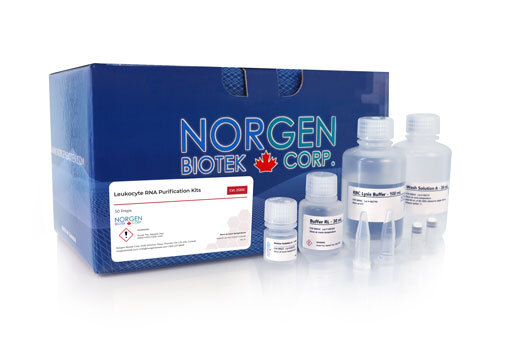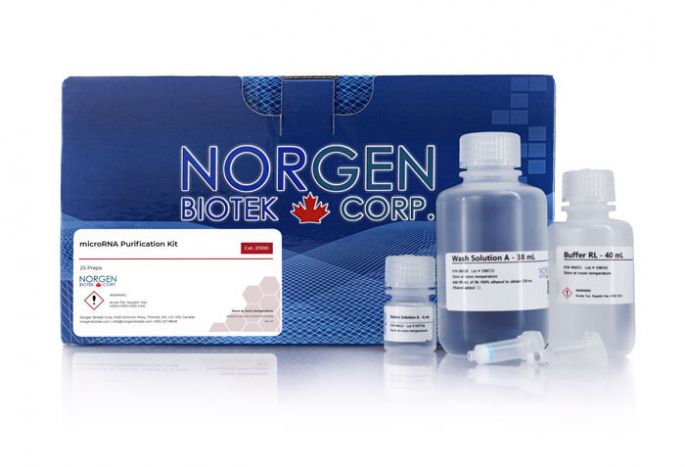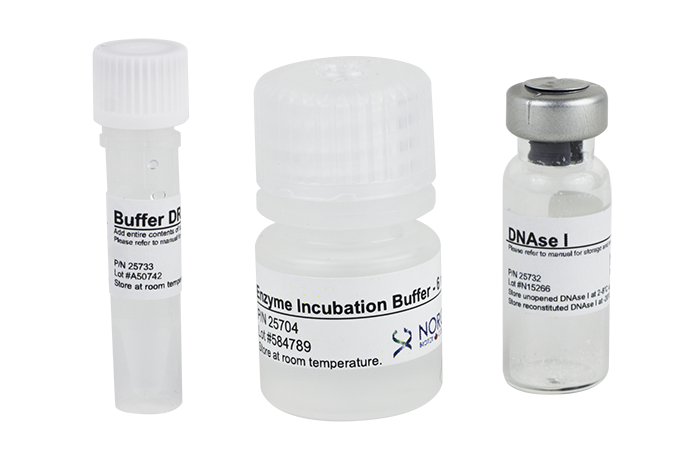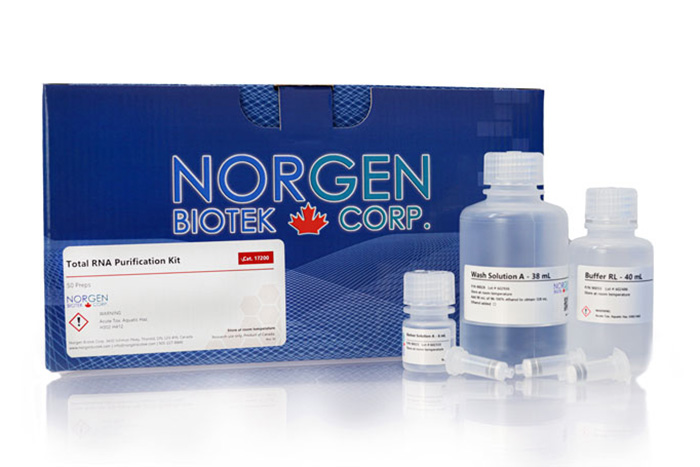Cytoplasmic and Nuclear RNA Purification Kit

For research use only and NOT intended for in vitro diagnostics.
Cytoplasmic and Nuclear RNA Purification Kit
Register today to receive an exclusive 15% off* on your first order.
Supporting Data
Figure 1. Effective Separation of HeLa Cell Cytoplasmic & Nuclear RNA. Norgen's Cytoplasmic & Nuclear RNA Purification Kit was used to effectively separate cytoplasmic and nuclear RNA from 0.75 million HeLa cells in triplicate. Panel A: High quality cytoplasmic and nuclear RNA was purified using Norgen's kit. Note the integrity and quality of both cytoplasmic and nuclear RNA. Ten microliters of each 50 µL elution were run on a 1.5% formaldehyde-agarose gel. Lane M is Norgen's 1 kb RNA Ladder, lanes 1-3 contain nuclear RNA and lanes 4-6 contain cytoplasmic RNA. Panel B: Ten microliters of the above cytoplasmic and nuclear RNA isolated from HeLa cells using Norgen's kit was run on a 0.9% agarose DNA gel. Genomic DNA is clearly visible in the nuclear RNA fractions (lanes 1-3), however, no genomic DNA can be detected in the cytoplasmic RNA fractions (lanes 4-6). Note that an optional on-column DNase treatment protocol is provided to remove the genomic DNA in the nuclear fraction.
Figure 2. Superior Separation of HeLa Cell Cytoplasmic & Nuclear RNA. Norgen's Cytoplasmic & Nuclear RNA Purification Kit provides better separation of cytoplasmic and nuclear RNA from 0.8 million HeLa cells when compared to a leading competitor’s product. Panel A: Cytoplasmic and nuclear RNA purified from HeLa cells using Norgen's kit and a competitor's kit. Ten microliters of each 50 µL elution (Norgen or competitor's kit) of the cytoplasmic (C) or nuclear (N) RNA were run on a 1.5% formaldehyde-agarose gel. Higher yields of RNA with good integrity were isolated using Norgen's kit. Panel B: Ten microliters of the cytoplasmic and nuclear RNA isolated from HeLa cells using Norgen's kit and the competitor's kit was run on a 0.9% agarose gel. Genomic DNA only co-migrates with the nuclear fraction in RNA isolated using Norgen’s Cytoplasmic & Nuclear RNA Purification Kit, not the cytoplasmic fraction. Note that an optional on-column DNase treatment protocol is provided to remove the genomic DNA in the nuclear fraction. In contrast, significant genomic DNA contamination was observed in the cytoplasmic fraction of the RNA isolated using the competitor's kit.
Figure 3. Genomic DNA-free Cytoplasmic RNA. RT-PCR was performed using human beta actin primers on 2 µL of the 50 µL of cytoplasmic RNA isolated from 1 million HeLa cells using Norgen's Cytoplasmic & Nuclear RNA Purification Kit. Lane M is Norgen's PCR Sizer DNA ladder, Lanes 1 and 3 are the negative control (PCR only, without reverse transcript), and Lanes 2 and 4 are the actual RT-PCR that show the expected 166 bp RT-PCR product. The expected amplicon size from the gene copy is the same as that from the RNA transcript. The lack of product in lanes 1 and 3 indicates that no genomic DNA contamination is present in the isolated cytoplasmic RNA. All PCR products were resolved on a 1X TAE, 2% agarose gel.
Figure 4. Specific Separation and Subsequent Amplification of Cytoplasmic and Nuclear Transcripts. Norgen's Cytoplasmic & Nuclear RNA Purification Kit effectively separates cytoplasmic and nuclear RNA. RT-PCR was performed using human U2 snRNA (Panel A) or S14 (Panel B) primers on 0.5 µg of either cytoplasmic or nuclear RNA fractions isolated from 1 million HeLa cells using Norgen's Cytoplasmic & Nuclear RNA Purification Kit. In Panel A, an intense PCR product was observed only in the nuclear fraction when the nuclear-specific U2 snRNA primers were used. In Panel B, the majority of the PCR product for the house-keeping transcript of S14 was observed in the cytoplasmic fraction. The two results combined showed effective separation of the cytoplasmic and nuclear RNA using Norgen's Cytoplasmic & Nuclear RNA Purification Kit. All PCR products were resolved on a 1X TAE, 1.5% agarose DNA gel.
|
Kit Specifications
|
|
|
Maximum Column Binding Capacity
|
Up to 50 µg RNA
|
|
Maximum Column Loading Volume
|
650 µL
|
|
Size of RNA Purified
|
All sizes, including small RNA (< 200 nt)
|
| Time to Complete 10 Purifications |
45 minutes
|
|
RNA Yield
HeLa (1 x 106) - Cytoplasmic RNA HeLa (1 x 106) - Nuclear RNA |
15 µg ≤ 3.5 µg |
Storage Conditions and Product Stability
All solutions should be kept tightly sealed and stored at room temperature. This kit is stable for 2 years after the date of shipment.
| Component | Cat. 21000 (50 preps) | Cat. 37400 (100 preps) |
|---|---|---|
| Lysis Buffer J | 20 mL | 2 x 20 mL |
| Buffer SK | 40 mL | 2 x 40 mL |
| Wash Solution A | 38 mL | 2 x 38 mL |
| Elution Buffer E | 6 mL | 2 x 6 mL |
| Mini Spin Columns | 50 | 100 |
| Collection Tubes | 50 | 100 |
| Elution Tubes (1.7 mL) | 50 | 100 |
| Product Insert | 1 | 1 |
Documentation
FAQs
Spin Column
Poor RNA recovery could be due to one or more of the following:
- Insufficient solubilization of cells or tissue.
Ensure that the appropriate amount of Lysis Buffer J was used for the amount of cells or tissue.
- Column has become clogged.
Do not exceed the recommended amounts of starting materials. The amount of starting material may need to be decreased if the column shows clogging below the recommended levels. See FAQ related to “Clogged Column” below.
- An alternative elution solution was used.
It is recommended that the Elution Buffer E supplied with this kit be used for maximum RNA recovery.
- Ethanol was not added to the lysate.
Ensure that the appropriate amount of ethanol is added to the lysate before binding to the column.
- Ethanol was not added to the Wash Solution A.
Ensure that 90 mL of 96-100% ethanol is added to the supplied Wash Solution A prior to use.
- Cell Culture: Cell monolayer was not washed with PBS.
Ensure that the cell monolayer is washed with the appropriate amount of PBS in order to remove residual media from cells.
Column clogging can result from one or a combination of the following factors:
- Insufficient solubilization of cells or tissues.
Ensure that the appropriate amount of Lysis Buffer J was used for the amount of cells or tissue.
- Maximum number of cells or amount of tissue exceeds kit specifications.
Refer to specifications to determine if the amount of starting material falls within kit specifications.
- High amounts of genomic DNA present in sample.
The nuclear lysate fraction may be passed through a 25 gauge needle attached to a syringe 5-10 times in order to shear the genomic DNA prior to loading onto the column.
- Centrifuge temperature is too low.
Ensure that the centrifuge remains at room temperature throughout the procedure. Temperatures below 15℃ may cause precipitates to form that can cause the columns to clog.
RNA can be degraded due to the following factors:
- RNase contamination.
RNases may be introduced during the use of the kit. Ensure proper procedures are followed when working with RNA. Please refer to “Working with RNA” at the beginning of this user guide.
- Procedure not performed quickly enough.
In order to maintain the integrity of the RNA, it is important that the procedure be performed quickly. This is especially important for the Cell Lysate Preparation Step in the Animal Tissue protocol, since the RNA in animal tissues is not protected after harvesting until it is disrupted and homogenized.
- Improper storage of the purified RNA.
For short term storage, RNA samples may be stored at –20℃ for a few days. It is recommended that samples be stored at –70℃ for longer term storage.
- Frozen tissues or cell pellets were allowed to thaw prior to RNA isolation.
Do not allow frozen tissues to thaw prior to grinding with the mortar and pestle in order to ensure that the integrity of the RNA is not compromised.
- Tissue samples were frozen improperly.
Samples should be flash-frozen in liquid nitrogen and transferred immediately to a -70℃ freezer for long-term storage.
If the RNA does not perform well in downstream applications, it may be due to one or more of the following:
- RNA was not washed 3 times with the provided Wash Solution A.
Traces of salt from the binding step may remain in the sample if the column is not washed 3 times with Wash Solution A. Salt may interfere with downstream applications, and thus must be washed from the column.
- Ethanol carryover.
Ensure that the dry spin under the Column Wash procedure is performed in order to remove traces of ethanol prior to elution. Ethanol is known to interfere with many downstream applications.
Genomic DNA contamination could be because traces of nuclear pellet remained in cytoplasmic fraction. Ensure that a solid pellet is formed at the end of the Cell Fraction Preparation step, and that none of the pellet is removed when the supernatant is transferred to another tube.
Please refer to supporting data Fig 4 where we have shown a qPCR for U2 snRNA which is amplified only in nuclear fraction, and also a qPCR for S14 RNA which is amplified in cytoplasmic fraction.





